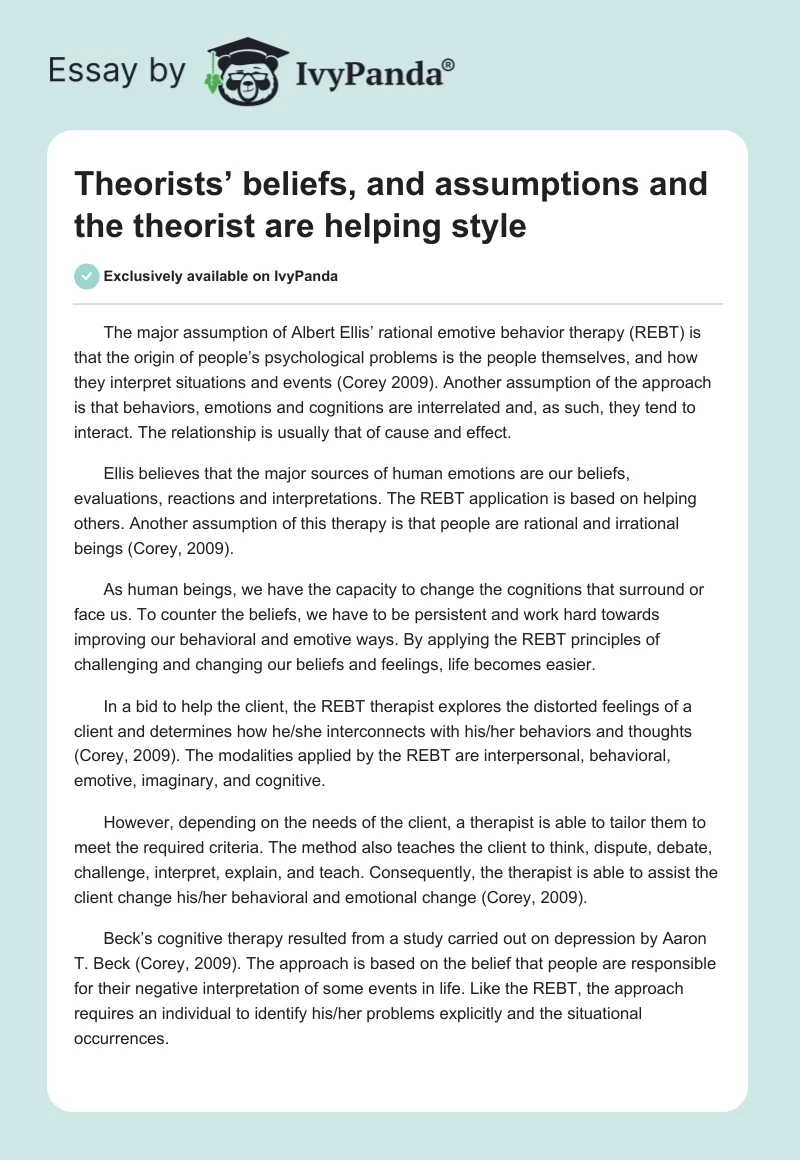The major assumption of Albert Ellis’ rational emotive behavior therapy (REBT) is that the origin of people’s psychological problems is the people themselves, and how they interpret situations and events (Corey 2009). Another assumption of the approach is that behaviors, emotions and cognitions are interrelated and, as such, they tend to interact. The relationship is usually that of cause and effect.
Ellis believes that the major sources of human emotions are our beliefs, evaluations, reactions and interpretations. The REBT application is based on helping others. Another assumption of this therapy is that people are rational and irrational beings (Corey, 2009).
As human beings, we have the capacity to change the cognitions that surround or face us. To counter the beliefs, we have to be persistent and work hard towards improving our behavioral and emotive ways. By applying the REBT principles of challenging and changing our beliefs and feelings, life becomes easier.
In a bid to help the client, the REBT therapist explores the distorted feelings of a client and determines how he/she interconnects with his/her behaviors and thoughts (Corey, 2009). The modalities applied by the REBT are interpersonal, behavioral, emotive, imaginary, and cognitive.
However, depending on the needs of the client, a therapist is able to tailor them to meet the required criteria. The method also teaches the client to think, dispute, debate, challenge, interpret, explain, and teach. Consequently, the therapist is able to assist the client change his/her behavioral and emotional change (Corey, 2009).
Beck’s cognitive therapy resulted from a study carried out on depression by Aaron T. Beck (Corey, 2009). The approach is based on the belief that people are responsible for their negative interpretation of some events in life. Like the REBT, the approach requires an individual to identify his/her problems explicitly and the situational occurrences.
The perception of the CT is that psychological problems stem from faulty thinking and the inability to distinguish between reality and fantasy (Corey, 2009). The major belief of the approach is that the way people behave and feel determines the outcome of their feelings and behavior.
Cognitive therapists assume that a more significant way of changing dysfunctional emotions and behaviors is by modifying dysfunctional and inaccurate thinking (Corey, 2009). This is achieved by teaching the client how to identify dysfunctional and distorted cognition through self evaluation. The continued process enables the client to have an influence over his/her behavior, feelings, and environmental events.
Upon an understanding of the technique, the client undergoes training that enables him/her to test the new thoughts. Clients are able to examine and weigh the thoughts and also monitor the rate at which negative behaviors and dysfunctional emotions affect their personal lives.
The therapist engages the client in a Socratic dialogue where homework assignments have to be completed (Corey, 2009). Data gathering is also undertaken, records kept and alternative interpretation of the results formed. The continued process ensures that the client is able to effectively undertake the problem solving process and apply the coping skills as well (Corey, 2009).
Lastly, the therapy focuses on problems that have affected the client in the past and at the moment as well. These are normally revisited once the current problems have been solved. The past helps the therapist to understand the originality of the dysfunctional beliefs (Corey, 2009).
Lastly, the Donald’s Cognitive Meichenbaum’s Behavior Modification mainly focuses on how to change the self verbalizations of the client (Corey, 2009). The basic principle of the approach is that personal statement influences an individuals’ behavior greatly. The preposition of the CBM is that the client should be able to notice his/her thinking, feelings and behavior as well as their impact on others (Corey, 2009).
This implies that clients should be able to interpret the nature of their behavior. The major assumption which is also shared in the REBT and the CT is that maladaptive thoughts bring about distressing emotions. In this case, a therapist helps the client to self -train and understands his/her self-talk (Corey, 2009).
The therapeutic teaching process involves educating clients on the creation of self statements and the modification of the self allocated instructions. This training helps the client to effectively cope with any encounters in life. Through role-play, the client and the therapist are able to practice desirable behaviors and self-instructions.
This practice helps the client to understand what aspects of their lives stimulate distressing behaviors. Basically, it teaches the client to avert fear associated with taking tests, being impulsive, or speaking in public (Corey, 2009). In order to change a particular behavior, the client should interact with their inner speech, resultant outcomes, behaviors, and cognitive structures.
They should never lose focus of the above mentioned aspects. The three major steps prescribed under the CBM are self observation, acquisition of new internal dialogue, and knowing new skills (Corey, 2009). Skills learning involve teaching clients new ways of coping with their problems.
The success depends on what the clients focuses on while self-taking. Basically, the CBM approach is self centered and allows the client to monitor their self-statements and learn how to positively transform them.
Reference
Corey, G. (2009). Theory and practice of counseling and psychotherapy (8th ed., pp.275-311). Australia: Thomson/Brooks/Cole.


